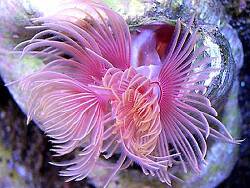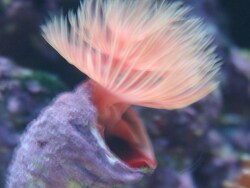Info
Protula bispiralis (Savigny, 1822)
Protula bispiralis is a colorful tubeworm and a real eye-catcher, but needs a special care / supply / co-stock to be able to be kept in the long term!
Is often described as difficult.
Is the care then also, if one does not feed or has an organically loaded tank.
If one does this however and feeds the tubeworm regularly then it is certainly maintainable.
But if you don't want to do this, because you are afraid that the water values will deteriorate, you should leave the lime tube worm alone.
Especially Cylop Eeze and Ultramin are suitable for this purpose.
Feed selectively, so that not so much is lost.
Is often common in the trade, unlike Spirobranchus giganteus, which is more spiral and can therefore be easily distinguished.
Supplemental feeding is really important, even though these animals don't need these amounts that are often added to the tanks.
In contrast to Spirobranchus giganteus, which is more spiral shaped and can therefore be easily distinguished.
With good water values the animals grow quite fast, which can be seen clearly in the fresh calcium deposits.
Important is the correct positioning in the reef aquarium, so that no other animal can reach the tube from behind.
Synonymised names
Protula (Philippiprotula) magnifica Straughan, 1967 · unaccepted (subjective synonym)
Protula magnifica Straughan, 1967 · unaccepted (subjective synonym)
Serpula (Spiramella) bispiralis Savigny, 1822 · unaccepted (superseded original combination)
Serpula bispiralis Savigny, 1822 · unaccepted (superseded original combination)
Spiramella bispiralis (Savigny, 1822) · unaccepted (superseded recombination)
Protula bispiralis is a colorful tubeworm and a real eye-catcher, but needs a special care / supply / co-stock to be able to be kept in the long term!
Is often described as difficult.
Is the care then also, if one does not feed or has an organically loaded tank.
If one does this however and feeds the tubeworm regularly then it is certainly maintainable.
But if you don't want to do this, because you are afraid that the water values will deteriorate, you should leave the lime tube worm alone.
Especially Cylop Eeze and Ultramin are suitable for this purpose.
Feed selectively, so that not so much is lost.
Is often common in the trade, unlike Spirobranchus giganteus, which is more spiral and can therefore be easily distinguished.
Supplemental feeding is really important, even though these animals don't need these amounts that are often added to the tanks.
In contrast to Spirobranchus giganteus, which is more spiral shaped and can therefore be easily distinguished.
With good water values the animals grow quite fast, which can be seen clearly in the fresh calcium deposits.
Important is the correct positioning in the reef aquarium, so that no other animal can reach the tube from behind.
Synonymised names
Protula (Philippiprotula) magnifica Straughan, 1967 · unaccepted (subjective synonym)
Protula magnifica Straughan, 1967 · unaccepted (subjective synonym)
Serpula (Spiramella) bispiralis Savigny, 1822 · unaccepted (superseded original combination)
Serpula bispiralis Savigny, 1822 · unaccepted (superseded original combination)
Spiramella bispiralis (Savigny, 1822) · unaccepted (superseded recombination)







 robertbaur
robertbaur


















